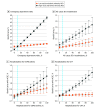Association Between Organizational Quality and Out-of-Network Primary Care Among Accountable Care Organizations That Care for High vs Low Proportions of Patients of Racial and Ethnic Minority Groups
- PMID: 35977323
- PMCID: PMC9012967
- DOI: 10.1001/jamahealthforum.2022.0575
Association Between Organizational Quality and Out-of-Network Primary Care Among Accountable Care Organizations That Care for High vs Low Proportions of Patients of Racial and Ethnic Minority Groups
Abstract
Importance: Medicare accountable care organizations (ACOs) that disproportionately care for patients of racial and ethnic minority groups deliver lower quality care than those that do not, potentially owing to differences in out-of-network primary care among them.
Objective: To examine how organizational quality is associated with out-of-network primary care among ACOs that care for high vs low proportions of patients of racial and ethnic minority groups.
Design setting and participants: A retrospective cohort study was conducted between March 2019 and October 2021 using claims data (2013 to 2016) from a national sample of Medicare beneficiaries. Among beneficiaries who were assigned to 1 of 528 Medicare ACOs, a distinction was made between those treated by organizations that cared for high (vs low) proportions of patients of racial and ethnic minority groups. For each ACO, the amount of out-of-network primary care that it delivered annually was determined. Multivariable models were fit to evaluate how the quality of care that beneficiaries received varied by the proportion of care provided to patients of racial and ethnic minority groups by the ACO and its amount of out-of-network primary care.
Exposures: The degree of care provided to patients of racial and ethnic minority groups by the ACO and its amount of out-of-network primary care.
Main outcomes and measures: The ACO quality assessed with 5 preventive care services and 4 utilization metrics.
Results: Among 3 955 951 beneficiary-years (2 320 429 [58.7%] women; 71 218 [1.8%] Asian, 267 684 [6.8%] Black, 44 059 [1.1%] Hispanic, 4922 [0.1%] North American Native, and 3 468 987 [87.7%] White individuals and 56 157 [1.4%] of Other race and ethnicity), those assigned to ACOs serving many patients of racial and ethnic minority groups at the mean level of out-of-network primary care were less likely than those assigned to ACOs serving fewer patients of racial and ethnic minority groups to receive diabetic retinal examinations (predicted probability, 49.4% [95%CI, 49.0%-49.7%] vs 51.6% [95% CI, 51.5%-51.8%]), glycated hemoglobin testing (predicted probability, 58.5% [95% CI, 58.2%-58.5%] vs 60.4% [95% CI, 60.3%-60.6%]), or low-density lipoprotein cholesterol testing (predicted probability, 85.2% [95% CI, 85.0%-85.5%] vs 86.0% [95% CI, 85.9%-86.1%]). They were also more likely to experience all-cause 30-day readmissions (predicted probability, 16.4% [95% CI, 16.1%-16.7%] vs 15.7% [95% CI, 15.6%-15.8%]). However, as the level of out-of-network primary care decreased, these gaps closed substantially, such that beneficiaries at ACOs that served many and fewer patients of racial and ethnic minority groups in the lowest percentile of out-of-network primary care received care of comparable quality.
Conclusions and relevance: This large cohort study found that quality performance among ACOs serving many patients of racial and ethnic minority groups was negatively associated with their level of out-of-network primary care.
Copyright 2022 Bakre S et al. JAMA Health Forum.
Conflict of interest statement
Conflict of Interest Disclosures: Dr Herrel reported grants from the National Cancer Institute outside the submitted work. Dr Hollingsworth reported grants from National Institute on Aging (R01AG068074) during the conduct of the study. No other disclosures were reported.
Figures


Similar articles
-
Exit Rates of Accountable Care Organizations That Serve High Proportions of Beneficiaries of Racial and Ethnic Minority Groups.JAMA Health Forum. 2022 Sep 2;3(9):e223398. doi: 10.1001/jamahealthforum.2022.3398. JAMA Health Forum. 2022. PMID: 36218951 Free PMC article.
-
Consumer Assessment of Healthcare Providers and Systems Among Racial and Ethnic Minority Patients With Alzheimer Disease and Related Dementias.JAMA Netw Open. 2022 Sep 1;5(9):e2233436. doi: 10.1001/jamanetworkopen.2022.33436. JAMA Netw Open. 2022. PMID: 36166229 Free PMC article.
-
Disparities in Rates of Surgical Intervention Among Racial and Ethnic Minorities in Medicare Accountable Care Organizations.Ann Surg. 2019 Mar;269(3):459-464. doi: 10.1097/SLA.0000000000002695. Ann Surg. 2019. PMID: 29420318
-
Racial and ethnic minority representation in dementia risk factor research: a scoping review of cohort studies.BMJ Open. 2024 Sep 25;14(9):e085592. doi: 10.1136/bmjopen-2024-085592. BMJ Open. 2024. PMID: 39322589 Free PMC article.
-
The Effectiveness of Collaborative Care on Depression Outcomes for Racial/Ethnic Minority Populations in Primary Care: A Systematic Review.Psychosomatics. 2020 Nov-Dec;61(6):632-644. doi: 10.1016/j.psym.2020.03.007. Epub 2020 Apr 3. Psychosomatics. 2020. PMID: 32381258 Free PMC article.
References
-
- Agency for Healthcare Research and Quality . 2014 National healthcare quality & disparities report. Accessed November 11, 2019. https://archive.ahrq.gov/research/findings/nhqrdr/nhqdr14/index.html

